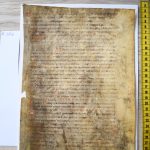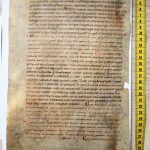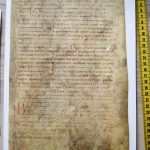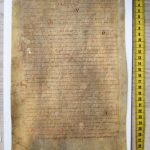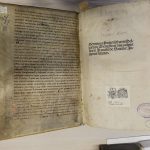The leaves of the 12th-century notated breviary were used to strenghten a copy of Pelbárt Temesvári’s Pomerium, a volume of sermons for the feasts of the saints. The volume was published in 1501, in Hagenau as a result of the joint work of the printer Heinrich Gran and the publisher Johann Rynmann.
As reinforcement of the binding, codex leaves were glued to both inner sides of the pigskin covered wooden boards. Because of the gluing, only one side of each parchment leaf was accessible previously. In 2021, the leaves were detached from the boards, this way both sides of the leaves became visible.
The order of leaves was not subsequent in the mother codex. The fragment on the front board preserved the end of the Matins of Candlemas’s office (the second and third responsory of the last Nocturn) and its Lauds, almost completely. On the fragment detached from the back board the office of Annuntiation and the commune chants of Eastertide are visible. The chants of the Mary-office of March 25th are lining up from the last responsory of the matins all to the Magnificat antiphon of the second vespers, in most cases indicated only by their incipit. This allows us to assume, that they were completely notated earlier, presumedly in the first vespers, or even earlier, in the Advent time of the proprium de tempore. In the first little hours the antiphons of the vespers and lauds (Missus est, Ave Maria) are repeated, however, the sext and none got new chants fully notated with text and music. These two antiphons (Vidi portam, Portam quam vidisti) can be documented in a narrower cirlcle of sources than the others, it can be foud sparsely in different regions (Würtzburg, Quedlinburg, St. Gallen) of the German speech area (comp. cantusindex: http://cantusindex.org/id/005499; http://cantusindex.org/id/201512).
The fragment of the back board is taken up by the Eastertide’s 10 nocturnal responsory and its long lauds-cycle of 22 antiphones. Though the block arrangement is typical to the liturgical-musical material of the commune sanctorum tempore paschali, such an abundance of chants is not often found in the sources. Besides the rubric sanctis in pasce standing at the beginning of the office and the matutina laus inscription at the beginning of the antiphon cycle, only one further rubric with identical text divides the series after the 10th antiphon. The rubrics do not contain any information as to which block of cycle of which saint-type’s office belongs to. A comparative analysis of European sources also shows that these antiphon series frequently mingled with each other, there were no strict boundaries between the antiphon cycles for the feast of martyrs and confessors of Eastertide: certain pieces could belong to more than one series. The fragment’s 22 Lauds-antiphons are predominantly composed of chants common throughout Europe, grouped and arranged diversely in the sources for the feasts of saints of Eastertide, which do not have proper chants. The only exceptions are the antiphons Vos estis qui permansistis mecum and Ego sum in medio vestri that can only be found in a few Italian and French sources, as well as in the 11th-century Quedlinburg antiphonal (comp. http://cantusindex.org/id/005499; http://cantusindex.org/id/201512).
After the commune chants of Eastertide the office of St George (In natalis sancti Georgii) begins with the incipit of the capitulum Beatus vir, followed by a complete notated antiphon and a prayer. Based on this modest set we cannot rule out the possibility that the codex included a complete office for St. George, continuing on the following pages, though it is more likely, that it inserted only this single antiphon into the series of chants borrowed from the Common of Martyrs. Whether they used common chants, or the former office was built from proper ones, the antiphon Sanctus vir Georgius is doubtlessly remarkable. It is quite rarely notated in Medieval sources. It was unknown in Hungary: we cannot found any trace of it in the Codex Albensis’ George-office, which is almost the same age as the present fragment. (Codex Albensis, Graz, Universitätsbibliothek Ms. 211, f. 93r-94r). International plainchant databases only know a single source of this antiphon: the notated breviary of ÖNB in Vienna dated around 1200, with the shelf mark 1890 contains it embedded in a complete proper George-office as a chant of the Prime (the source is available at https://manuscripta.at/ directly: https://digital.onb.ac.at/RepViewer/viewer.faces?doc=DTL_2976033&order=1&view=SINGLE). The exact provenance of the breviary is unknown, but it was presumably written in a Benedictine monastery in the Southern-German–Austrian region. Former research associated it with the Abbey of St. Ulrich and Afra in Augsburg, but more recently Robert Klugseder attributed it to the Abbey of Mondsee (Quellen zur mittelalterlichen Musik- und Liturgiegeschichte des Klosters Mondsee.” Codices manuscripti 91, Ergänzungen zu Supplement 7 (2013): 45–56). Based on the detailed comparison of the neumes, we assume that the melody on the fragment is identical to the antiphon melody of the Southern German breviary.
Zsuzsa Czagány


